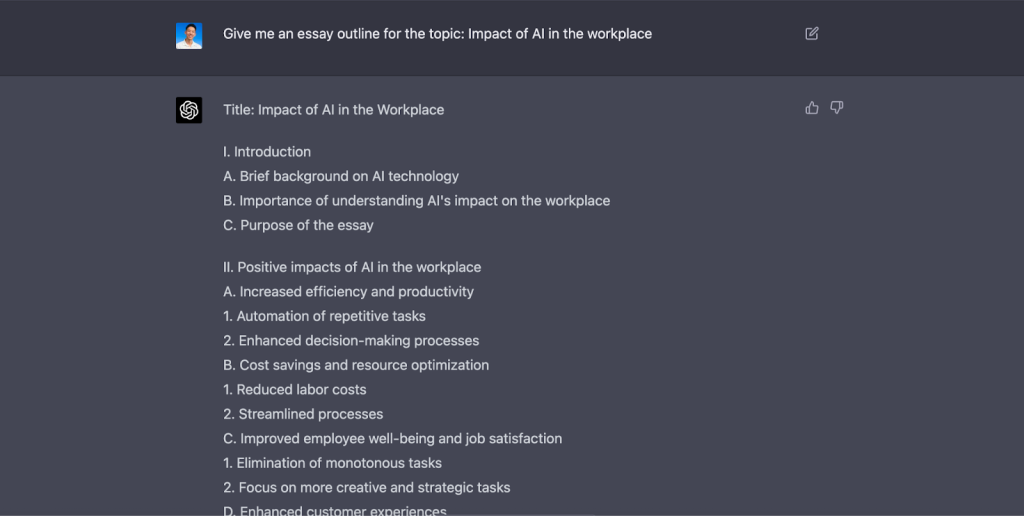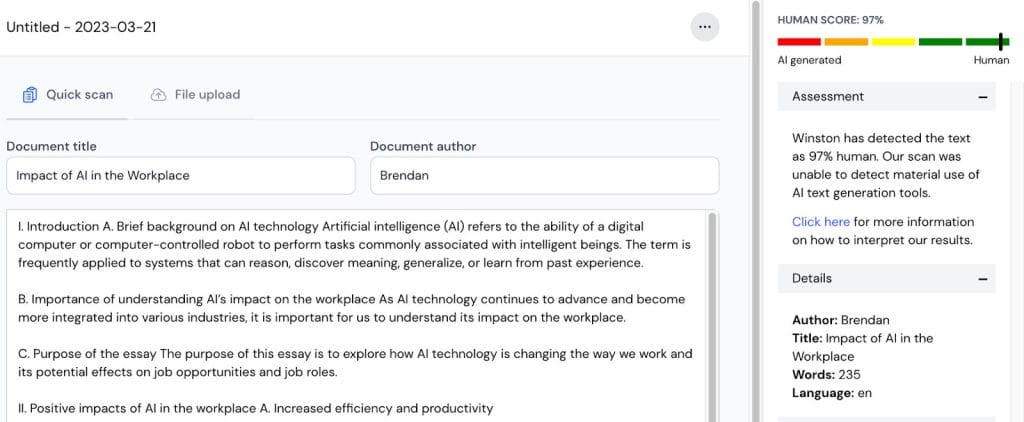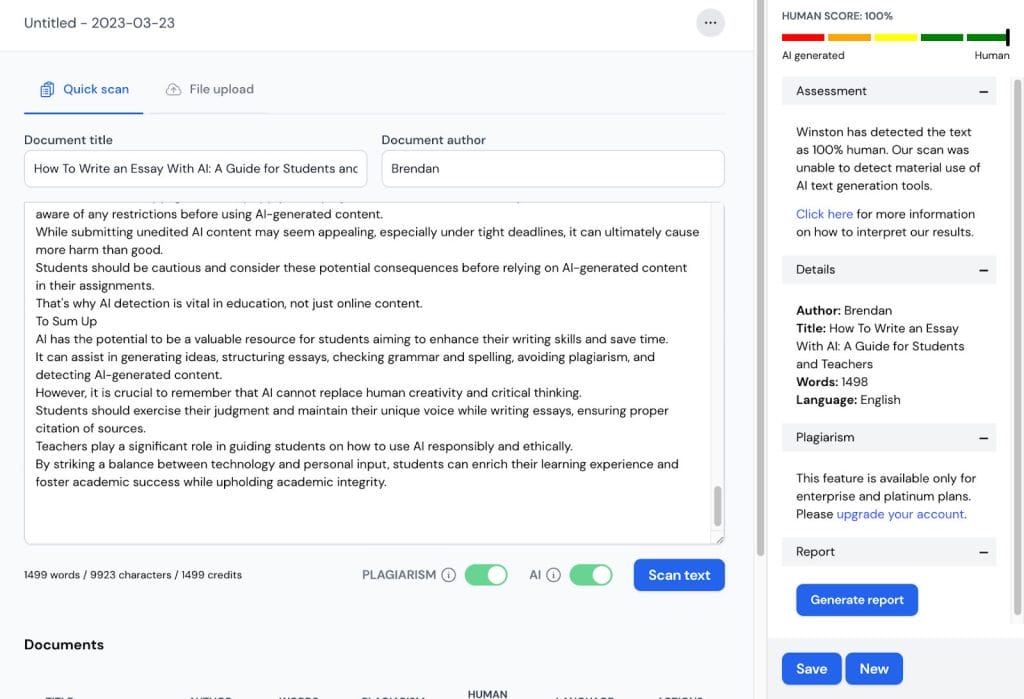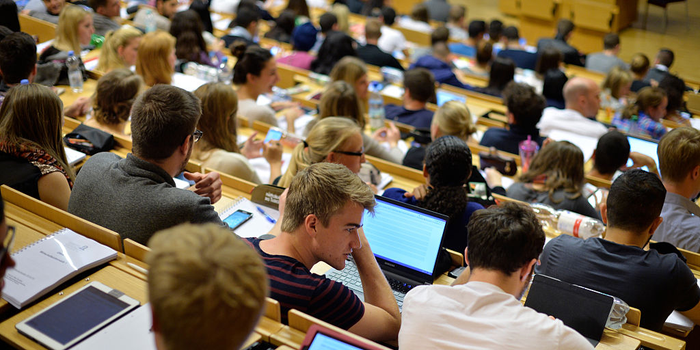Writing an essay with AI can be a great way to save time and energy, but it’s essential to do it the right way.
ChatGPT is undoubtedly one of the most popular AI content writers students use to generate content quickly.
This technology has become integral in our daily lives, and there’s no escaping that.
But if the proper steps aren’t taken when using this tool, students could end up in hot water for plagiarism or even getting caught by AI detection systems.
Teachers, on the other hand, have to be privy to this technology to maintain academic integrity and quality in their classrooms.
In this article, you will learn:
- How to write an essay using AI the right way
- Pros and cons of using AI writers for essays
- Implications of submitting unedited AI content
- Other important notes
Let’s get started.
What Are the Steps to Writing an Essay With AI
It’s important to note that AI-generated essays are becoming increasingly common in academic settings, so understanding how to write one correctly is essential for students and teachers alike.
Here are the steps that should be taken.
Step 1: Understand the Essay Requirements
Before writing an essay using AI, the person must fully understand the assignment’s requirements.
Carefully reading the instructions and gaining a clear grasp of the topic is essential.
They should note specific guidelines, such as length, formatting style, or required research sources.
Step 2: Research the Topic
The individual should research primary and secondary sources related to their topic to become well-versed in the subject matter.
This effort helps guarantee that the essay contains accurate and current facts and proves beneficial later when incorporating AI into the writing process.
AI is infamously known for fabricating stories, so a solid understanding of the topic will help ensure accuracy.
Step 3: Create an Essay Outline
Constructing an essay outline proves highly beneficial when working with AI writers, as it enables users to establish a logical structure upfront instead of relying on guesswork.
An AI tool like ChatGPT can generate a detailed essay outline using a simple prompt such as “Give me an essay outline for the topic: Impact of AI in the workplace.”

To begin, the individual should verify the ideas related to each section of their paper and use those concepts as headings to develop a thorough outline tailored to the assignment.
This outline will act as a guiding roadmap during the entire essay creation process.
Step 4: Write the Content
Now that you have crafted an ideal outline, it’s essential to maintain academic integrity while using AI to assist in writing the essay.
Teachers should be aware of the potential pitfalls of AI-generated content and guide students in using AI responsibly.
The appropriate way to utilize AI in essay writing is to employ it as a supplementary tool for generating ideas rather than relying on it to complete the entire essay.
AI tools like Bing Chat, Jasper, or Writesonic can produce content by scraping the web, offering more relevant results than ChatGPT, which was trained on data only until 2021.
For instance, Bing Chat, a free tool, can generate content for the introduction and sections A, B, and C while adding citations from credible sources.

However, students should not take AI-generated content for granted and must fact-check the information.
They should incorporate their domain knowledge about the assignment topic into each section, using AI-generated ideas as a starting point.
Once the essay is complete, students can use a free online writing assistant like Grammarly to refine grammar, spelling, punctuation, and tone.
The right way to write an essay using AI is to treat it as a helpful resource while ensuring academic integrity through personal input and fact-checking.
Teachers must also understand that AI isn’t going away, and it’s going to be used by students whether they like it or not.
The trick is to embrace this technology and, ironically, also use AI to encourage responsible, ethical practices in essay writing.
Step 5: Check for AI Content and Plagiarism
The last and most critical step involves running the completed essay through a tool like Winston AI, which checks for AI-generated content and plagiarism.
This is important because most academic institutions require students to submit their work through internal checking systems to ensure academic integrity.
In some cases, students may not be allowed to revise their work upon receiving a plagiarism score.
As these systems can now detect AI-generated content, it is essential for both students and teachers to scan the essay through a tool like Winston AI before submission.
This precaution helps students avoid penalties or potential expulsion.
And teachers can educate students about the importance of maintaining academic integrity and the risks associated with relying heavily on AI-generated content in their writing.

Pros and Cons of Using AI Writers for Essay Writing
Pros of AI Writers for Essay Writing
AI writers are gaining popularity among students, providing a range of benefits that can accelerate the writing process.
These automated systems generate high-quality content quickly with just a few user prompts, making them suitable for those facing tight deadlines or lacking traditional essay writing skills.
Some AI writers include built-in plagiarism checkers, enabling users to ensure their essays’ originality before submission.
Tools like Bing Chat can search the web for pertinent and up-to-date information while providing citations, making them ideal for essay writing where referencing credible sources is crucial.
Cons of AI Writers for Essay Writing
Despite the advantages of using AI writers, there are also drawbacks to consider.
Firstly, while these systems can produce quality content efficiently, they may struggle to understand context or nuance within the text, making them less appropriate for complex essays.
Secondly, there are ethical concerns regarding using such technology in academic settings, where creativity and originality should be prioritized over convenience.
Finally, even though most reputable providers strive for accuracy and reliability, occasional errors still occur, so it is essential to double-check all content carefully.
Teachers should be mindful of these potential issues and guide students on using AI writers responsibly while maintaining academic integrity.
What To Consider Before Using an AI Writer for Essays
When an individual considers using an AI writer for their essay needs, several factors should be considered:
- Budget: Most professional AI essay-writing software requires a paid subscription.
- Complexity: Assess whether AI models can generate relevant content for advanced or niche topics.
- Ethics: Determine personal comfort levels in utilizing technology rather than completing the work independently.
- Accuracy: Ensure the AI-generated content is reliable and properly sourced.
Although AI can save time grading papers and providing feedback on assignments, teachers must recognize that technology cannot replace the value of direct teacher-student interaction for effective teaching.
While incorporating technology into learning activities is crucial, overreliance on automated systems like AI writing assistants may not yield long-term benefits.
Instead, balancing technology and personal input is key to maintaining academic integrity and fostering meaningful learning experiences.
The Implications of Submitting Unedited AI Content
Submitting unedited AI content can have far-reaching and potentially damaging consequences for students.
As AI-generated content becomes more prevalent in completing assignments, students should know the drawbacks before submitting such material.
- Lack of Originality and Creativity: AI-generated content may appear similar to human-written essays, increasing the likelihood of plagiarism suspicions. Computers cannot think outside the box or develop creative solutions, resulting in ideas that lack depth and sophistication.
- Misrepresentation of Student Understanding: Relying heavily on AI-generated content may not accurately reflect a student’s true comprehension of the subject. Despite researching the topic, students may miss critical points by depending on automated programs instead of taking the time to understand the material themselves. This reliance can lead instructors to question students’ genuine understanding.
- Potential Legal Issues: Unedited AI content may have legal ramifications, depending on the location and the material created. Copyright laws may apply if the project includes content owned by others, so students should be aware of any restrictions before using AI-generated content.
While submitting unedited AI content may seem appealing, especially under tight deadlines, it can ultimately cause more harm than good.
Students should be cautious and consider these potential consequences before relying on AI-generated content in their assignments.
That’s why AI detection is vital in education, not just online content.
To Sum Up
AI has the potential to be a valuable resource for students aiming to enhance their writing skills and save time.
It can assist in generating ideas, structuring essays, checking grammar and spelling, avoiding plagiarism, and detecting AI-generated content.
However, it is crucial to remember that AI cannot replace human creativity and critical thinking.
Students should exercise their judgment and maintain their unique voice while writing essays, ensuring proper citation of sources.
Teachers play a significant role in guiding students on how to use AI responsibly and ethically.
By balancing technology and personal input, students can enrich their learning experience and foster academic success while upholding academic integrity.




